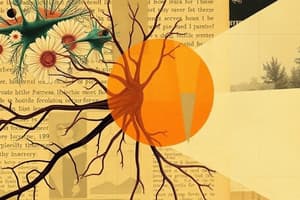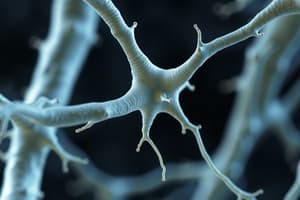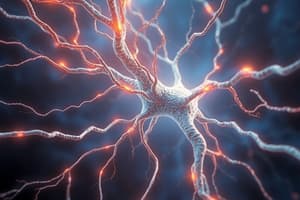Podcast
Questions and Answers
Which of the following is the main body of a neuron?
Which of the following is the main body of a neuron?
- Dendrite
- Synaptic
- Axon terminal
- Soma (correct)
Which neurotransmitter is the chief excitatory transmitter in the CNS?
Which neurotransmitter is the chief excitatory transmitter in the CNS?
- EK
- GABA
- ENa
- Glutamate (correct)
What type of summation occurs when EPSPs created by distant synapses overlap?
What type of summation occurs when EPSPs created by distant synapses overlap?
- Axon terminal summation
- Spatial summation (correct)
- Temporal summation
- Dendrite summation
Which of the following is true about dendrites?
Which of the following is true about dendrites?
Which ions are involved in creating an inhibitory post synaptic potential (IPSP)?
Which ions are involved in creating an inhibitory post synaptic potential (IPSP)?
Which ions are involved in creating an excitatory post synaptic potential (EPSP)?
Which ions are involved in creating an excitatory post synaptic potential (EPSP)?
What is the chief inhibitory transmitter in the adult CNS?
What is the chief inhibitory transmitter in the adult CNS?
What is the effector part of a neuron?
What is the effector part of a neuron?
Which of the following is an electrotonic response that decays with an exponential time course?
Which of the following is an electrotonic response that decays with an exponential time course?
What is the sensory portion of a neuron?
What is the sensory portion of a neuron?
Which lobe of the cerebral cortex is responsible for auditory perception, semantics, and memory?
Which lobe of the cerebral cortex is responsible for auditory perception, semantics, and memory?
Which lobe of the cerebral cortex is the visual processing center?
Which lobe of the cerebral cortex is the visual processing center?
Which division of the nervous system is responsible for responding to and moving about in our environment?
Which division of the nervous system is responsible for responding to and moving about in our environment?
Which level of CNS function controls subconscious body activities such as arterial pressure and respiration?
Which level of CNS function controls subconscious body activities such as arterial pressure and respiration?
Which portion of the nervous system performs specific functions but always functions in association with lower centers?
Which portion of the nervous system performs specific functions but always functions in association with lower centers?
What is the function of the primary motor cortex?
What is the function of the primary motor cortex?
Which level of CNS function contains the medulla, pons, mesencephalon, hypothalamus, thalamus, cerebellum, and basal ganglia?
Which level of CNS function contains the medulla, pons, mesencephalon, hypothalamus, thalamus, cerebellum, and basal ganglia?
What is the role of the somatosensory cortex?
What is the role of the somatosensory cortex?
Which division of the nervous system processes information and creates memory?
Which division of the nervous system processes information and creates memory?
What is the function of the cranial nerves?
What is the function of the cranial nerves?
Which type of transmitter is usually excitatory in the CNS?
Which type of transmitter is usually excitatory in the CNS?
What is the chief inhibitory transmitter in the CNS?
What is the chief inhibitory transmitter in the CNS?
What is the possible mechanism for causing an epileptic seizure to end?
What is the possible mechanism for causing an epileptic seizure to end?
Which type of transmitter causes long-term changes and acts on metabotropic receptors?
Which type of transmitter causes long-term changes and acts on metabotropic receptors?
What is the main function of small molecule, rapidly acting transmitters in the CNS?
What is the main function of small molecule, rapidly acting transmitters in the CNS?
What is the mechanism behind synaptic facilitation?
What is the mechanism behind synaptic facilitation?
What is the mechanism behind synaptic fatigue?
What is the mechanism behind synaptic fatigue?
What is the chief excitatory transmitter in the CNS?
What is the chief excitatory transmitter in the CNS?
What is the protective mechanism for excessive neuronal activity?
What is the protective mechanism for excessive neuronal activity?
What is the process that takes time in neurotransmission and can be used to calculate the number of chemically connected series neurons in a circuit?
What is the process that takes time in neurotransmission and can be used to calculate the number of chemically connected series neurons in a circuit?
Which division of the nervous system is responsible for processing information and creating memory?
Which division of the nervous system is responsible for processing information and creating memory?
Which lobe of the cerebral cortex is responsible for auditory perception, semantics, and memory?
Which lobe of the cerebral cortex is responsible for auditory perception, semantics, and memory?
Which type of transmitter is usually excitatory in the CNS?
Which type of transmitter is usually excitatory in the CNS?
Flashcards
What is the soma of a neuron?
What is the soma of a neuron?
The main body of a neuron, containing the nucleus and other organelles.
What is glutamate?
What is glutamate?
The chief excitatory neurotransmitter in the central nervous system (CNS).
What is spatial summation?
What is spatial summation?
A type of summation where EPSPs from different synapses on the same neuron occur close together in time.
What is the function of dendrites?
What is the function of dendrites?
Signup and view all the flashcards
What ions are involved in an IPSP?
What ions are involved in an IPSP?
Signup and view all the flashcards
What ions are involved in an EPSP?
What ions are involved in an EPSP?
Signup and view all the flashcards
What is GABA?
What is GABA?
Signup and view all the flashcards
What is the axon terminal?
What is the axon terminal?
Signup and view all the flashcards
What is EPSP?
What is EPSP?
Signup and view all the flashcards
What is the sensory portion of a neuron?
What is the sensory portion of a neuron?
Signup and view all the flashcards
What is the function of the temporal lobe?
What is the function of the temporal lobe?
Signup and view all the flashcards
What is the function of the occipital lobe?
What is the function of the occipital lobe?
Signup and view all the flashcards
What is the function of the motor division?
What is the function of the motor division?
Signup and view all the flashcards
What is the function of the lower brain level?
What is the function of the lower brain level?
Signup and view all the flashcards
What is the function of the cortex?
What is the function of the cortex?
Signup and view all the flashcards
What is the function of the primary motor cortex?
What is the function of the primary motor cortex?
Signup and view all the flashcards
What does the lower brain level include?
What does the lower brain level include?
Signup and view all the flashcards
What is the function of the somatosensory cortex?
What is the function of the somatosensory cortex?
Signup and view all the flashcards
What is the function of the integrative division?
What is the function of the integrative division?
Signup and view all the flashcards
What is the function of cranial nerves?
What is the function of cranial nerves?
Signup and view all the flashcards
What are small molecule, rapidly acting transmitters?
What are small molecule, rapidly acting transmitters?
Signup and view all the flashcards
What is the function of GABA?
What is the function of GABA?
Signup and view all the flashcards
What can end an epileptic seizure?
What can end an epileptic seizure?
Signup and view all the flashcards
What are neuropeptides, slowly acting transmitters?
What are neuropeptides, slowly acting transmitters?
Signup and view all the flashcards
What is the main function of small molecule, rapidly acting transmitters in the CNS?
What is the main function of small molecule, rapidly acting transmitters in the CNS?
Signup and view all the flashcards
What is the mechanism behind synaptic facilitation?
What is the mechanism behind synaptic facilitation?
Signup and view all the flashcards
What is the mechanism behind synaptic fatigue?
What is the mechanism behind synaptic fatigue?
Signup and view all the flashcards
What is glutamate?
What is glutamate?
Signup and view all the flashcards
What is the protective mechanism for excessive neuronal activity?
What is the protective mechanism for excessive neuronal activity?
Signup and view all the flashcards
What process can be used to calculate the number of neurons in a circuit?
What process can be used to calculate the number of neurons in a circuit?
Signup and view all the flashcards
What is the function of the integrative division?
What is the function of the integrative division?
Signup and view all the flashcards
What is the function of the temporal lobe?
What is the function of the temporal lobe?
Signup and view all the flashcards
What are small molecule, rapidly acting transmitters?
What are small molecule, rapidly acting transmitters?
Signup and view all the flashcards




